Apple iPad mini with Retina Display: Reviewed
by Anand Lal Shimpi on November 16, 2013 8:00 AM ESTThe Display
The big story behind the new iPad mini is of course its 7.85-inch Retina Display. We’re talking about the same 2048 x 1536 resolution as the iPad Air, but in a much smaller form factor. The result is the highest pixel density of any Apple display ships today, tying with the iPhone 5S. The impact on the overall experience is pretty significant. Text is obviously a lot sharper, but even graphics are a lot nicer to look at on the new Retina Display. The gains aren't quite as obvious as they were on the larger iPad, but after living with the Retina mini for a while I can't easily go back to the previous version.

iPad mini (left) vs. iPad mini with Retina Display (right)
I ran Marco Arment's image retention test on the Retina mini and didn't see even the slightest degree of image retention. My old, non-Retina iPad mini on the other hand exhibited image retention. I suspect Apple is multi-sourcing its displays here, which could obviously contribute to varied behavior. At least on the two minis I have, image retention isn't an issue.
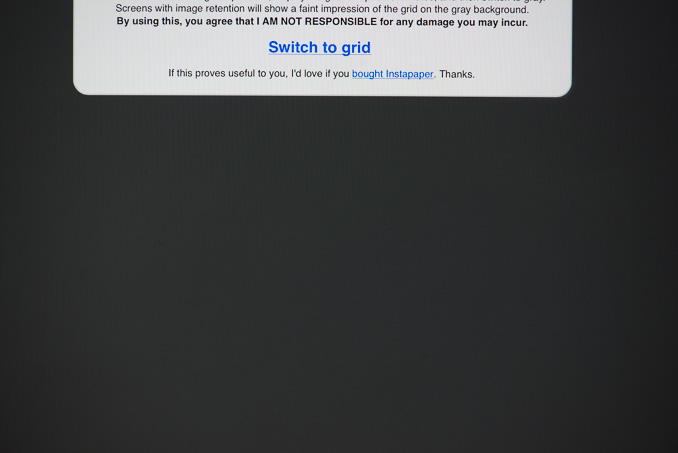
In the conclusion of my iPad Air review I wrote about the new mini as finally being a no-compromises smaller iPad. Much like my assertions last year of a Retina mini not being in the cards, it turns out that I was wrong on this point as well. Although display resolution is no longer a concern on the mini, color gamut hasn’t changed between the old and new minis. A quick look at our gamut test gives us an idea of what’s going on:

The iPad mini with Retina Display has the same color gamut as the standard iPad mini, which is narrower than the iPad Air and less than the sRGB coverage we normally look for. The biggest issue here is that there are other smaller tablets in this price range that do offer sRGB coverage (e.g. Nexus 7, Kindle Fire HDX 8.9).
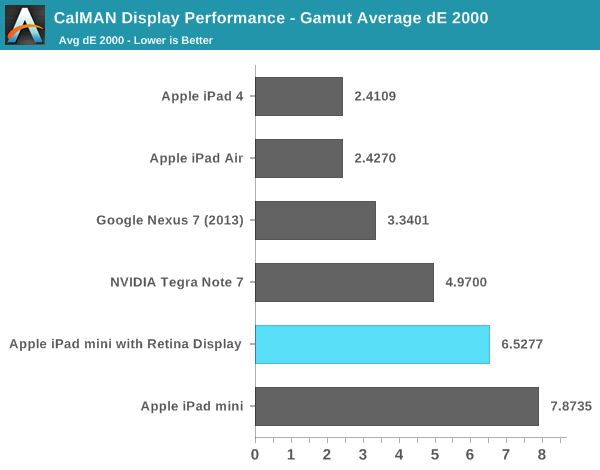
I suspect the justification here is Apple likely views the bigger iPad as being a better fit for photographers/those who care about color reproduction, but it’s a shame that this is a tradeoff that exists between the two iPads especially given how good Apple is about sRGB coverage in nearly all of its other displays.
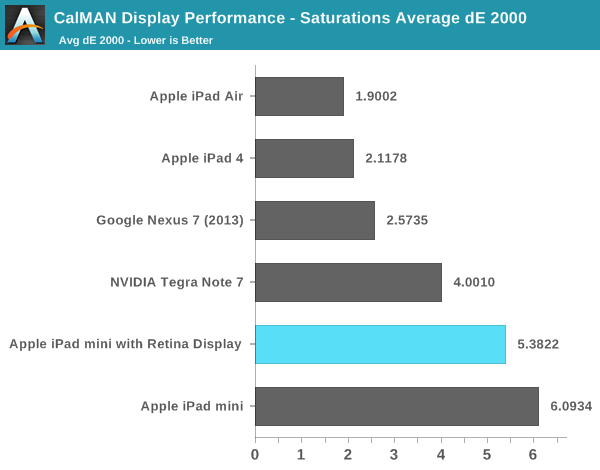

One of the simplest visual tests is to use one of iOS 7’s more colorful wallpapers and compare the Retina mini and iPad Air side by side:
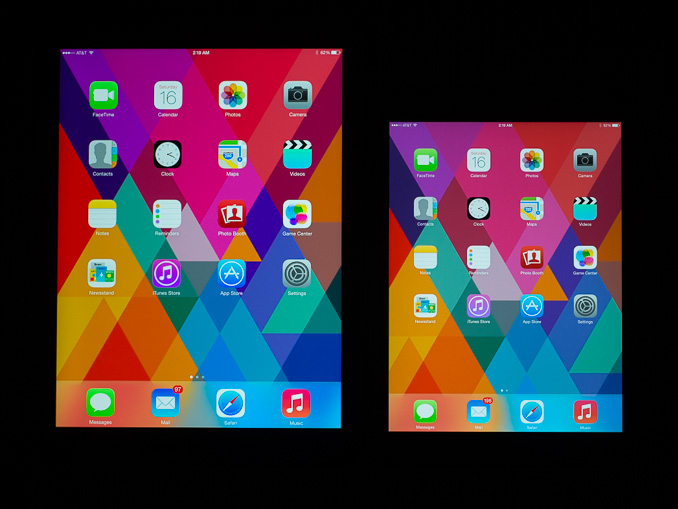
Pay attention to the color of the red triangles in the lower left
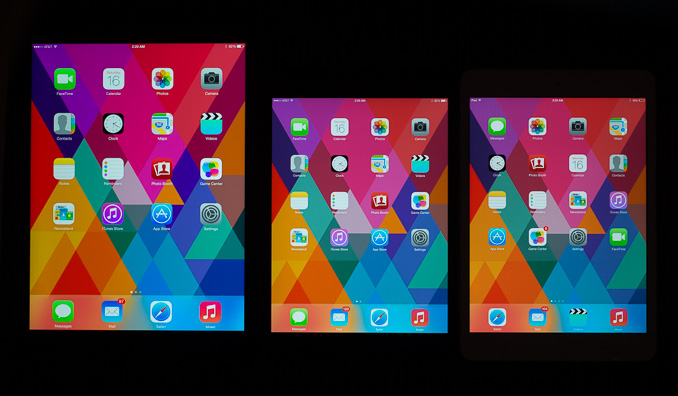
From left to right: iPad Air, iPad mini with Retina Display, iPad mini
The difference is small but apparent, particularly if you’re used to panels with full sRGB coverage like the iPad Air or any of the rMBPs/iMacs. The biggest deviations are in reds/blues and magenta in between as you can tell from the CIE chart above.

Within its gamut coverage, the mini’s panel is fairly accurate. A look at our GMB checker test shows performance competitive with the Nexus 7 and not far off the 4th generation iPad. Grayscale reproduction is also quite good. The display looks really good otherwise, but you don’t get the same visual punch you do on the iPad Air.
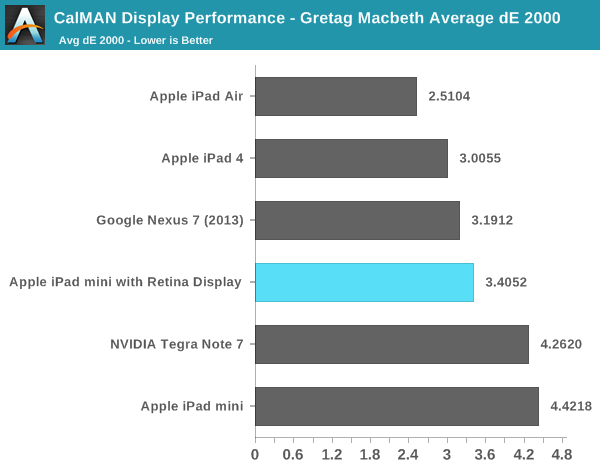

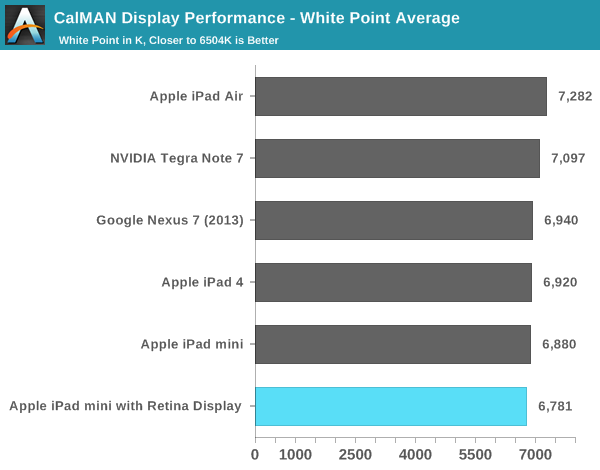
Compared to the previous generation mini we’re obviously talking about a much better panel. But for those of you on the fence between the mini and Air, the Air does still hold a display advantage.
Black levels are competitive and contrast ratio stays fixed at around 800:1 regardless of whether we’re talking about max brightness or the 200 nits we run all of our battery life tests at. Max brightness is down a bit compared to the iPad Air.
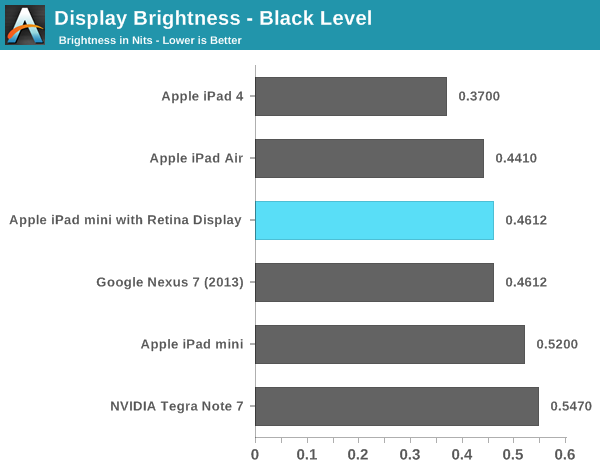
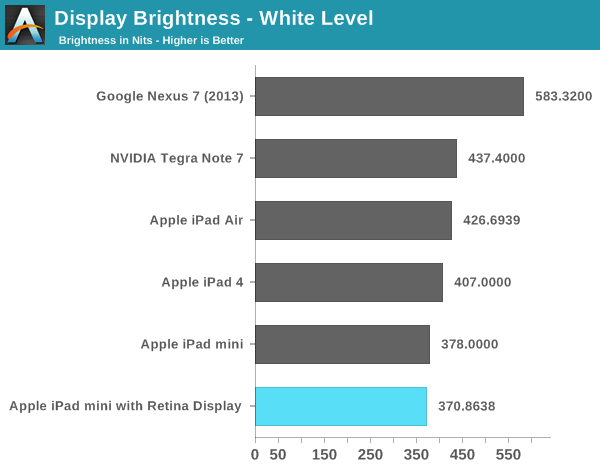
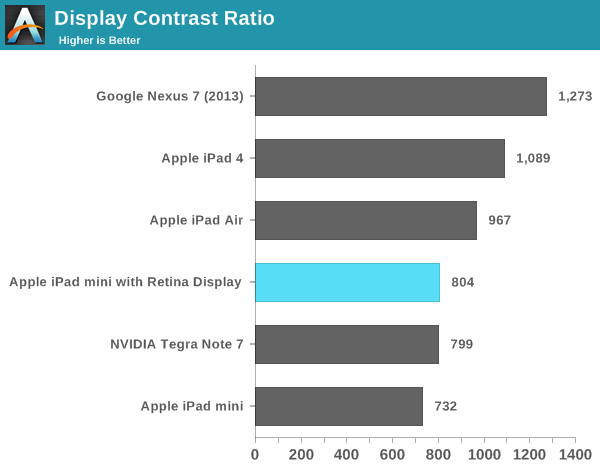










345 Comments
View All Comments
BPB - Saturday, November 16, 2013 - link
Came here just to see if the Apple love would be 10 out of 10, or 11 out of 10. Not surprised it's an 11.Jaaap - Saturday, November 16, 2013 - link
There are also al lot of verifiable facts in the article.BearT - Saturday, November 16, 2013 - link
Liked the article: 1. The display of iPad mini w/ Retina is superb, and its size dwarfs that of others in this category (e.g. Nexus 7). This matters to me as I read magazines in portrait mode. 2. I tried the browsers from a number of devices. The "Reader" feature of Safari is a must, if you loathe online ads as much as I do. 3. The high fidelity of the FaceTime "audio" is uncanny; one has to try it to appreciate the "pin-drop" sound across the globe, okay, just the long-distance. The normal phone audio doesn't come close in clarity!eggcustard - Sunday, November 17, 2013 - link
I use Readability on my N7.RannXeroxx - Sunday, November 24, 2013 - link
Looks like an interesting app, going to try it out. Thanks.julandorid - Sunday, November 17, 2013 - link
Actually, the final rating is pretty accurate! The review mention all of the important flaws as the quality of the display which is still decent but not quite as good as it is on the Nexus 7. Also a very important thing is the price. The author of this review is not convinced that (double) price is justified anyhow. Actually the contrary. He practically encourage the buyers to take the Nexus 7 in serious consideration.My personal opinion is the display is not that bad as it is described, but it is entirely a conscious decision made by Apple to calibrate the display with much lower brightens in order to achieve a good battery and correct gamma. If they decided to put an extra power to the led backlight and does a different calibration then I guess we would have a better screen but in the expense of pretty bad battery life. Apple did a smart move by offering great performance and good battery life. Probably no body will notice the display since it is already better (I mean sharper) that it was previously. That gives Apple another chance, next year to advertize an even better iPad mini.
The only serious concern that I have is the price! It is a known fact for years that Apple never rise the price (because it is already too high anyway) and always keep it the same while refreshing the product's internal and external components with better ones. However this year they decided to do the opposite - to increase the price even further.
So, for me was no-brainer to go with the new Nexus 7. Great device, great display. I always smile when I look at it.
Mahadragon - Sunday, November 17, 2013 - link
True, Apple generally keeps the price of devices like the iPhone and iPad the same. The iPhone 5S is the same price as the iPhone 5, however, you fail to take into consideration that the iPhone 5S has the same screen as the iPhone 5. The 5S has a finger print sensor and uses the A7 processor, those were the upgrades.The iPad Mini (original) made 2 steps up in processing power going from the A5 to the A7 processor and made a massive leap in resolution going to the retina screen. The Mini Retina also requires a much larger battery than the previous Mini to power all that nice hi-resolution screen which actually forced Apple to make an iPad Mini that is thicker and slightly heavier than the previous generation.
In short, the upgrade path from the original Mini to the Mini Retina was not a standard upgrade. It was a massive upgrade which prompted a much larger price increase.
winkgood - Monday, November 18, 2013 - link
Sounds like you are just making excuses for Apple. When they went from the ipad 2 (non-retina) to ipad 3 (retina), they kept the same price even though the new device has a better soc and higher resolution. (2 steps up)I believe they kept the same price point when they went from the iphone 3gs to 4 and from the 4s to 5, both of which involved improved screens and better guts. (2 steps up)
They got greedy and wanted to keep their insanely high margins.
ws3 - Monday, November 18, 2013 - link
Apple's margins are not insanely high, as proven by the fact that for most of their products, they sell everything they make. How long has the iPhone 5s been out now and most Apple stores still can't keep them in stock.ELPCU - Monday, November 18, 2013 - link
There is no doubt that Apple's margin are insanely high. Especially in phone area, they are making a tons of margin per phone. I do not know how can u say this stupid argument. Don't you see how expensive every fucking Apple accessory is? Don't you see how much apple makes u pay for increase tiny bit of storage? Go check isuppli, and look up their bill of material.I need to admit iPad, especially iPad mini series with 16GB wifi's margin is not too high, but margin from iphone per every fucking phone is just ridiculus. Why? because your phone cost is very deceptive, since 2/3~ish price is hidden under contract. You feels you are just paying 200 bucks per phone(for lowest storage), but apple takes bunch of money from AT&T or T-mobile, etc. You are actually paying 650 bucks(unlocked phone price). Most of iphone series have approximately SAMEish bill of material. around 200 bucks including manufactuing cost, and margin rates of higher storage one gets increased even more.
Bill of material is not exact number used for calculating margin, because of warranty cost, marketing cost, licensing cost, etc, but if you uses 150% of BOM, which will give very close number of real unit price.
Which means apple is making more than 100% margin rate in phone market.
You think more than 100% of margin rate is not insanely high? you must be kidding me.